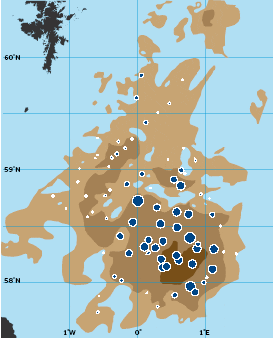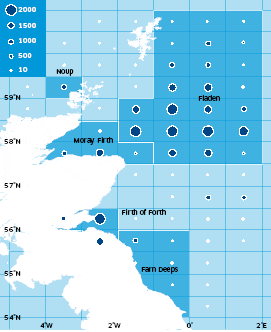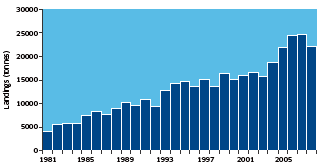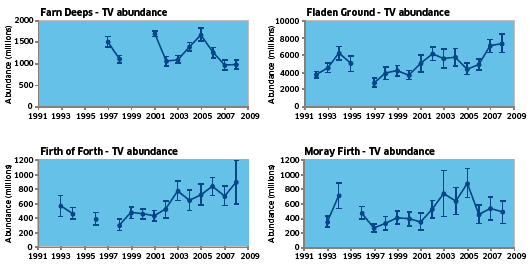Introduction
There are Nephrops fisheries on grounds around Scotland, the largest being the fladen Ground in the North Sea. Most Nephrops are caught by trawlers, but creel fisheries are also important, particularly on the west coast of Scotland. Scotland is allocated the majority of the Total Allowable Catches (TAC) in both the North Sea and Scottish west coast and takes approximately one third of the landings worldwide.
Biology and life cycle

Nephrops distribution is limited by the extent of suitable muddy sediment in which animals construct burrows. There are populations in the North Sea and waters to the west of Scotland, in open waters and sea lochs at depths ranging from a few metres down to over 500 m on the shelf edge, west of the hebrides.
Nephrops spend most of their time in burrows, only coming out to feed and look for a mate. They are opportunistic predators, primarily feeding on crustaceans, molluscs and polychaetes. female Nephrops usually mature at three years of age and reproduce each year thereafter. After mating in early summer, they spawn in September, and carry eggs under their tails (described as being ‘berried’) until they hatch in April or May. The larvae develop in the plankton before settling to the seabed six to eight weeks later. reproductive timing may be slightly delayed in the deeper areas of the fladen Ground.
Nephrops in different areas grow at different rates and mature at different sizes. This is related to the density of animals and sediment type. on the softest mud, Nephrops density is low, but the animals grow relatively fast, and reach a larger maximum size (‘clonkers’). on sandier mud, Nephrops density is much higher, but the animals grow relatively slowly, and are smaller (‘beetles’). In the North Sea there are differences in growth between stocks, while on the west coast, there are also differences between areas within the same stock.

Since most Nephrops fishing is by trawling, and animals are protected from trawls when in burrows, these emergence patterns are very important. The timing of emergence to feed appears related to light level, and greatest catches are often taken at dawn and dusk, although this may vary with water depth and clarity. As ‘berried’ females rarely come out of the burrow, they are naturally protected from trawlers, and males dominate trawl catches for most of the year, and are more heavily exploited than females.
Assessments
For the purposes of stock assessment, Nephrops around Scotland are split into a number of stocks or ‘functional units’ (fus) based on the discrete patches of mud which they inhabit. unlike fish, Nephrops cannot be aged directly and therefore the assessments make use of size composition data from catches, combined with information on stock abundance obtained from underwater television (UWTV) surveys. UWTV cameras are used on research vessel surveys to estimate Nephrops burrow density on the seabed. The information gathered provides an index of stock abundance for each fu which is independent of the fishery, and burrow emergence patterns. By applying a number of ‘correction’ factors to the index, an estimate of the absolute abundance of Nephrops is obtained.

Introduction
In the North Sea, Scottish fishermen exploit Nephrops in the farn deeps, firth of forth, Moray firth, fladen Ground and to a lesser extent at the Noup and devil’s hole. Most are caught by trawlers targeting Nephrops. In some areas, particularly the fladen Ground, they are also caught by whitefish trawlers. fishing effort has increased overall, but spatial expansion of the fishery at the fladen since the mid-1908s has resulted in a redistribution of this effort. The fladen Ground is by far the largest fu and accounts for more than 50 per cent of the total North Sea landings.
State of stocks

In 2009, ICES conclusions about Nephrops stock status were based on trends in the UWTV survey, fishery and catch size composition data. for areas lacking UWTV survey information (Noup and devil’s hole), ICES did not update its advice on stock status in 2009.

Farn Deeps: the UWTV survey, fishery data and length frequency data all point to the stock at the start of the 2008 fishing season continuing to be at a low level. recruitment signals for Nephrops in 2008 appear to indicate low recruitment.
Fladen Ground: The UWTV survey indicates that the stock is fluctuating without obvious trend with estimates for the last two years increasing to the highest abundance in the series. Taken together with stable mean sizes in the length composition of catches, this suggests that the stock is being exploited sustainably. The decline in mean length of smaller individuals in the catch may be indicative of recent good recruitment.
Firth of Forth: the UWTV survey suggests that the population has been at a relatively high level since 2003. Taken together with information showing stable mean sizes, this suggests the stock is being exploited sustainably.
Moray Firth: the UWTV survey suggests that the population is stable but at a lower level than that evident in 2003-2005. Taken together with information showing stable mean sizes, this suggests the stock is being exploited sustainably.
Management advice
The advice aims to control exploitation rate by suggesting TACs for individual fus which are estimated as a fixed proportion (‘harvest rate’) of the UWTV abundance estimate. ICES advised that this ‘harvest rate’ should be at a level which is consistent with high long term yield and low risk of depletion of production potential. Target harvest rates corresponding to fishing at F0.1 to FMAX were recommended. for a number of fus the advised harvest rate implies a significant reduction in catch. In these cases ICES has suggested that since there does not seem to be any immediate biological risk to the stocks, incremental reductions in fishing mortality towards the target could be considered.
Management action
ICES management advice is formulated for Nephrops fus, whereas management has continued to be applied to the larger ICES finfish areas. STECF supports the ICES ACoM advice for management at a smaller scale and emphasised the need for effort management and whitefish by-catch mitigation measures.
June 2010

